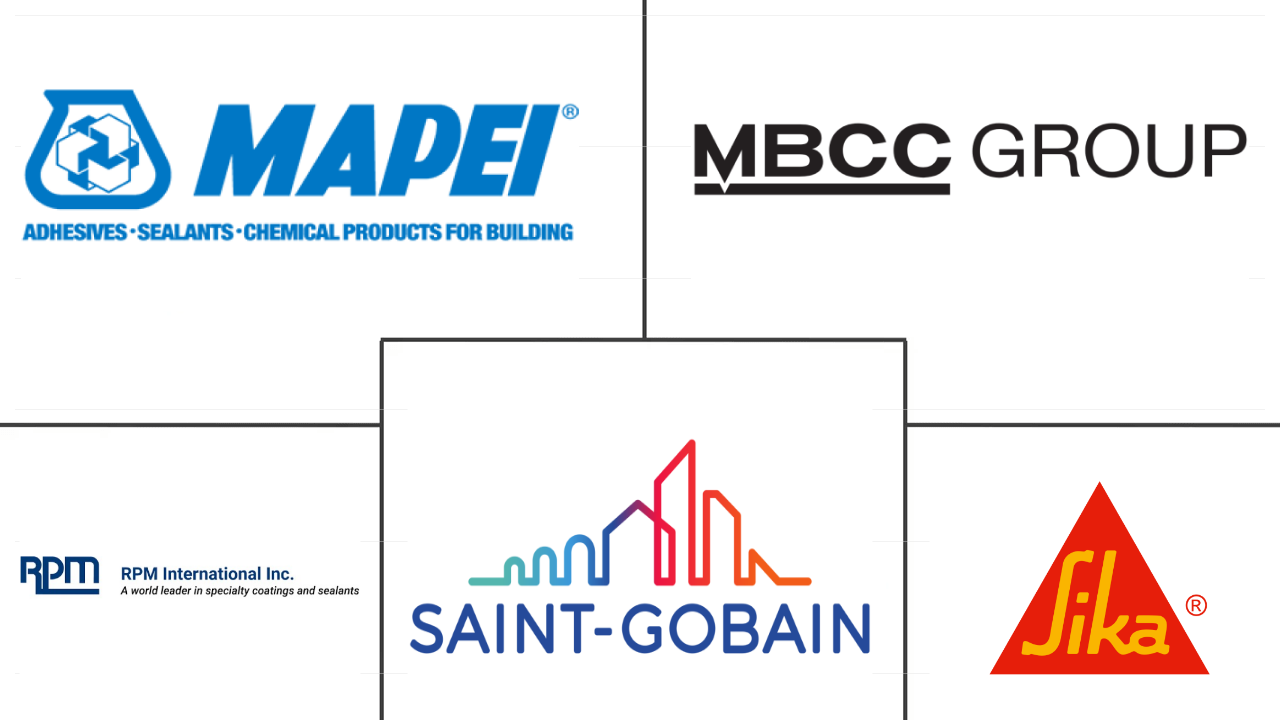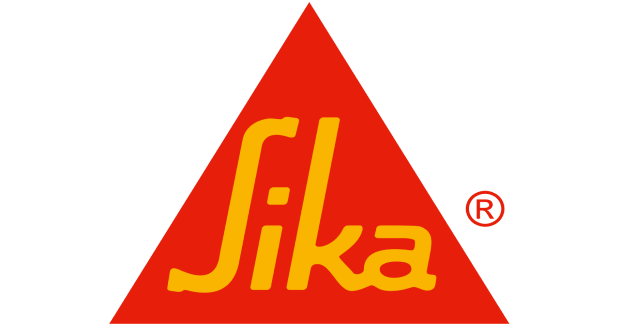Market Size of construction repair and rehabilitation chemicals Industry
| Icons | Lable | Value |
|---|---|---|
|
|
Study Period | 2018 - 2030 |
|
|
Market Size (2024) | USD 2.96 Billion |
|
|
Market Size (2030) | USD 4.33 Billion |
|
|
Largest Share by End Use Sector | Industrial and Institutional |
|
|
CAGR (2024 - 2030) | 6.56 % |
|
|
Largest Share by Region | Asia-Pacific |
|
|
Market Concentration | Medium |
Major Players |
||

|
||
|
*Disclaimer: Major Players sorted in no particular order |
Construction Repair and Rehabilitation Chemicals Market Analysis
The Construction Repair and Rehabilitation Chemicals Market size is estimated at 2.96 billion USD in 2024, and is expected to reach 4.33 billion USD by 2030, growing at a CAGR of 6.56% during the forecast period (2024-2030).
2.96 Billion
Market Size in 2024 (USD)
4.33 Billion
Market Size in 2030 (USD)
4.75 %
CAGR (2018-2023)
6.56 %
CAGR (2024-2030)
Largest Market by Sub Product
43.95 %
value share, Injection Grouting Materials, 2023
Due to increasing usage in various repairing applications, such as filling cracks, open joints, voids, etc., in various end-user sectors, the injection grouting materials segment has dominated the market.
Largest Market by End Use Sector
48.48 %
value share, Industrial and Institutional, 2023
The sector has occupied the largest market share due to the high consumption of repair and rehabilitation chemicals from industrial buildings for renovation, maintenance, etc.
Largest Market by Region
36.34 %
value share, Asia-Pacific, 2023
The region dominated the market due to growing construction industrial activity and the increasing demand for repair and rehabilitation chemicals in countries like China, India, Japan, and South Korea.
Fastest Market by Region
7.06 %
Projected CAGR, Asia-Pacific, 2024-2030
The Asia-Pacific region is expected to grow fastest due to growing investments in infrastructure projects, government initiatives, fast-paced urbanization, and industrialization.
Leading Company
17.75 %
market share, Sika AG, 2022

The company's broad range of high-quality products, well-established network, robust supply chain, and strategic expansions and acquisitions in the construction industry make it a major player in the market.
Rising industrial construction is likely to drive the demand for repair and rehabilitation chemicals
- The global market for repair and rehabilitation chemicals experienced a 4.72% growth in value in 2022, driven by rising demand from the commercial and industrial and institutional construction sectors. This growth was estimated to continue in 2023, with a projected rate of 4.64% compared to 2022.
- In 2022, the industrial and institutional sector emerged as the dominant consumer, accounting for approximately 48.20% of the repair and rehabilitation chemicals market. This sector's floor area was set to expand by 9.02 billion square feet in 2023, primarily fueled by increased investments in industrial, education, and healthcare construction. Consequently, the demand for repair and rehabilitation chemicals in this sector is expected to rise by about 5.25% in 2023.
- Looking ahead, the industrial and institutional sector is poised to maintain its growth trajectory, with a projected CAGR of 7% in value from 2023 to 2030. The global existing floor area for this sector is forecasted to reach 360 billion square feet in 2023 and further climb to 429 billion square feet by 2030, driven by heightened industrial construction investments worldwide. Furthermore, several economies such as India, Indonesia, and Vietnam have shown rapid expansion that considerably impacted the need for an industrial property to meet the demands of efficient factories in the countries. As a result, the market for repair and rehabilitation chemicals in this sector is anticipated to surge from USD 1.33 billion in 2023 to USD 2.15 billion in 2030.
- Therefore, the market studied is expected to witness substantial growth during the forecast period.
The future of the construction repair and rehabilitation chemicals market is set to be influenced by the GDP growth of Asia-Pacific countries
- The global construction repair and rehabilitation chemicals market witnessed a 5% increase in terms of value in 2022, driven by a surge in building and infrastructure renovations. These initiatives aimed to boost economic growth and enhance energy efficiency standards. The global construction repair and rehabilitation chemicals market is projected to record a further 4.6% growth in 2023 by value, with North America and Asia-Pacific leading the way.
- Asia-Pacific, led by countries such as China, Japan, and India, dominates the global consumption of repair and rehabilitation chemicals. These three nations alone accounted for 28% of the market's value in 2022. Notably, micro-concrete mortars emerged as a significant contributor to the Asia-Pacific market, following injection grouting materials.
- Europe ranks second in terms of repair and rehabilitation chemical consumption, with Germany, France, and the United Kingdom being the primary contributors. In 2022, these three countries represented nearly 47% of Europe's market value. The industrial, institutional, and infrastructure segments are the major consumers of these chemicals in Europe.
- Asia-Pacific is projected to witness the highest growth in the construction repair and rehabilitation chemicals market, with a CAGR of 7.12% in terms of value from 2023 to 2030. This growth is likely to be fueled by the region's robust economies, including India, China, Thailand, and Japan. Notably, China and India's GDPs are growing at annual rates of 5.2% and 5.9%, respectively.
Construction Repair and Rehabilitation Chemicals Industry Segmentation
Commercial, Industrial and Institutional, Infrastructure, Residential are covered as segments by End Use Sector. Fiber Wrapping Systems, Injection Grouting Materials, Micro-concrete Mortars, Modified Mortars, Rebar Protectors are covered as segments by Sub Product. Asia-Pacific, Europe, Middle East and Africa, North America, South America are covered as segments by Region.
- The global market for repair and rehabilitation chemicals experienced a 4.72% growth in value in 2022, driven by rising demand from the commercial and industrial and institutional construction sectors. This growth was estimated to continue in 2023, with a projected rate of 4.64% compared to 2022.
- In 2022, the industrial and institutional sector emerged as the dominant consumer, accounting for approximately 48.20% of the repair and rehabilitation chemicals market. This sector's floor area was set to expand by 9.02 billion square feet in 2023, primarily fueled by increased investments in industrial, education, and healthcare construction. Consequently, the demand for repair and rehabilitation chemicals in this sector is expected to rise by about 5.25% in 2023.
- Looking ahead, the industrial and institutional sector is poised to maintain its growth trajectory, with a projected CAGR of 7% in value from 2023 to 2030. The global existing floor area for this sector is forecasted to reach 360 billion square feet in 2023 and further climb to 429 billion square feet by 2030, driven by heightened industrial construction investments worldwide. Furthermore, several economies such as India, Indonesia, and Vietnam have shown rapid expansion that considerably impacted the need for an industrial property to meet the demands of efficient factories in the countries. As a result, the market for repair and rehabilitation chemicals in this sector is anticipated to surge from USD 1.33 billion in 2023 to USD 2.15 billion in 2030.
- Therefore, the market studied is expected to witness substantial growth during the forecast period.
| End Use Sector | |
| Commercial | |
| Industrial and Institutional | |
| Infrastructure | |
| Residential |
| Sub Product | |
| Fiber Wrapping Systems | |
| Injection Grouting Materials | |
| Micro-concrete Mortars | |
| Modified Mortars | |
| Rebar Protectors |
| Region | ||||||||||||||
| ||||||||||||||
| ||||||||||||||
| ||||||||||||||
| ||||||||||||||
|
Construction Repair and Rehabilitation Chemicals Market Size Summary
The construction repair and rehabilitation chemicals market is poised for significant growth, driven by increasing demand from the commercial, industrial, and institutional construction sectors. The market is experiencing a robust expansion, with the industrial and institutional sector leading as the dominant consumer. This growth is fueled by substantial investments in industrial, education, and healthcare construction, particularly in rapidly expanding economies such as India, Indonesia, and Vietnam. The Asia-Pacific region, led by China, Japan, and India, dominates global consumption, with micro-concrete mortars and injection grouting materials being key contributors. Europe follows as a significant market, with Germany, France, and the United Kingdom being major consumers. The market's expansion is supported by the ongoing need for building and infrastructure renovations aimed at boosting economic growth and enhancing energy efficiency.
The global market for construction repair and rehabilitation chemicals is moderately consolidated, with major players like MAPEI S.p.A., MBCC Group, RPM International Inc., Saint-Gobain, and Sika AG holding significant market shares. Recent strategic moves, such as Sika's acquisition of the MBCC Group and the expansion of production capabilities in China, highlight the industry's focus on meeting growing demand. The market's growth trajectory is further supported by the increasing floor area in the commercial and residential sectors, driven by foreign direct investment and urbanization. The emphasis on affordable housing and residential renovations, particularly in regions like Europe and India, is expected to further stimulate market growth, aligning with the broader trends of urban expansion and economic development.
Construction Repair and Rehabilitation Chemicals Market Size - Table of Contents
-
1. MARKET SEGMENTATION (includes market size, forecasts up to 2030 and analysis of growth prospects.)
-
1.1 End Use Sector
-
1.1.1 Commercial
-
1.1.2 Industrial and Institutional
-
1.1.3 Infrastructure
-
1.1.4 Residential
-
-
1.2 Sub Product
-
1.2.1 Fiber Wrapping Systems
-
1.2.2 Injection Grouting Materials
-
1.2.3 Micro-concrete Mortars
-
1.2.4 Modified Mortars
-
1.2.5 Rebar Protectors
-
-
1.3 Region
-
1.3.1 Asia-Pacific
-
1.3.1.1 By Country
-
1.3.1.1.1 Australia
-
1.3.1.1.2 China
-
1.3.1.1.3 India
-
1.3.1.1.4 Indonesia
-
1.3.1.1.5 Japan
-
1.3.1.1.6 Malaysia
-
1.3.1.1.7 South Korea
-
1.3.1.1.8 Thailand
-
1.3.1.1.9 Vietnam
-
1.3.1.1.10 Rest of Asia-Pacific
-
-
-
1.3.2 Europe
-
1.3.2.1 By Country
-
1.3.2.1.1 France
-
1.3.2.1.2 Germany
-
1.3.2.1.3 Italy
-
1.3.2.1.4 Russia
-
1.3.2.1.5 Spain
-
1.3.2.1.6 United Kingdom
-
1.3.2.1.7 Rest of Europe
-
-
-
1.3.3 Middle East and Africa
-
1.3.3.1 By Country
-
1.3.3.1.1 Saudi Arabia
-
1.3.3.1.2 United Arab Emirates
-
1.3.3.1.3 Rest of Middle East and Africa
-
-
-
1.3.4 North America
-
1.3.4.1 By Country
-
1.3.4.1.1 Canada
-
1.3.4.1.2 Mexico
-
1.3.4.1.3 United States
-
-
-
1.3.5 South America
-
1.3.5.1 By Country
-
1.3.5.1.1 Argentina
-
1.3.5.1.2 Brazil
-
1.3.5.1.3 Rest of South America
-
-
-
-
Construction Repair and Rehabilitation Chemicals Market Size FAQs
How big is the Global Construction Repair and Rehabilitation Chemicals Market?
The Global Construction Repair and Rehabilitation Chemicals Market size is expected to reach USD 2.96 billion in 2024 and grow at a CAGR of 6.56% to reach USD 4.33 billion by 2030.
What is the current Global Construction Repair and Rehabilitation Chemicals Market size?
In 2024, the Global Construction Repair and Rehabilitation Chemicals Market size is expected to reach USD 2.96 billion.

